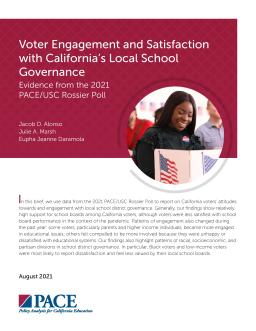Summary
Summary
We use data from the 2020 PACE/USC Rossier annual voter poll to report on California voters’ attitudes towards educational equity policy initiatives, specifically: (a) increasing the number of public school teachers of color in California and (b) requiring all high school students in California to complete an ethnic studies course. A majority of voters supported these initiatives. Respondents showed higher levels of support for increasing the number of teachers of color when informed about the positive academic impact this would likely have for students of color. Support varied depending on...
Summary
This report updates previous research on California's Local Control Funding Formula (LCFF) using a 2019 poll of California voters. Despite increased awareness, over half of voters are unfamiliar with LCFF. Support for the policy remains high but has decreased. Participation in LCFF engagement has increased but remains low, particularly among low-income voters. Low-income communities may not be meaningfully engaged in LCFF decision-making.
Summary
This brief analyzes the 2018 update of the California School Dashboard, examining improvements and areas for continued enhancement. Using data from the 2019 PACE/USC Rossier poll, the author characterizes use of and support for the Dashboard, finding low use, equity gaps, but high support and preference for the new Dashboard.



